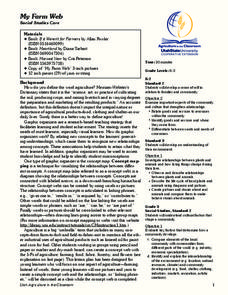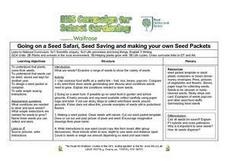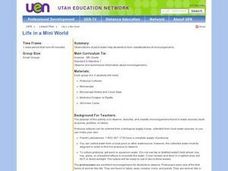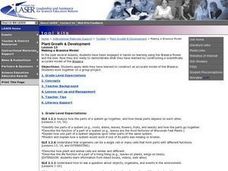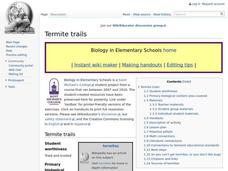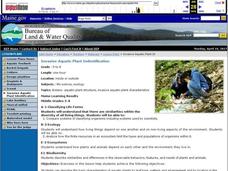Curated OER
COMPARE SOILS BY GROWING PLANTS
The student will identify the difference in the rate of plant growth in three soils that vary in organic matter.1. Obtain three to four flowerpots, different types of soil, a record chart, three to five beans for each pot, and water....
Curated OER
Wetland Adaptation
Fourth graders study the impact of the wetland environment on the migration of birds. They make a list of the important reasons on a large piece of paper to be posted in the classroom and point out the biggest wetland in the state (The...
Curated OER
Wonderfully Wild Unit
Learners become familiar with local birds. In this birds instructional activity, students explore local birds through a question and answer sheet. Learners complete a worksheet. Students maintain bird feeder.
Curated OER
My Farm Web
Students examine the role of agriculture in everyday life. In this agriculture activity, students read books such as Harvest Year and identify products which from from the farm. Students fill in a word web using the knowledge they gained...
Curated OER
Forensic Detectives: Chemistry at Work
Learners examine the different careers associated with chemistry and see how it is used everyday. For this forensic lesson students research a chemistry related career and write a presentation to give to the class.
Curated OER
Going on a Seed Safari
Students describe biology by identifying different plants in class. In this seed lesson, students discuss the process of how a plant grows from seed to leaves. Students attend a field trip to their garden or another park and collect a...
Curated OER
"What Insecit Am I"
Students play the game "What Insect Am I" to explore the parts of an insect and their habitats.
Curated OER
What Bees Eat
Pupils consider the concept that plants and animals are dependent on one another and role-play the interaction between bees and flowers. They identify crops that are dependent on pollination by bees.
Curated OER
Sound Vibrations
Students examine how vibrations are responsible for the sounds we hear. Students experience vibrations using several of their senses.
Curated OER
SOUND VIBRATIONS
Student designs a test that uses their sense of hearing to judge the effectiveness of different solids to transmit sound vibrations. Students experience vibrations using several of their senses.
Curated OER
Life in a Mini World
Sixth graders observe, describe, and classify microorganisms found in water sources. In small groups, they make their own slide, observe the Protozoa under a microscope, and record and classify the microorganisms.
Curated OER
Antacid Lesson Plan
Eleventh graders use titration methods to study properties of antacids. They look at the strength, effectiveness, PH, and effect of supplements taken at the same time. They make observations after the different mixtures are combined and...
Curated OER
Recombinant DNA to Protect Crops
Learners read an article about manipulation of plant DNA. After reading the short article, they work in small groups to respond to the provided discussion questions and explain their answer to the class.
Curated OER
Edible Soil
Students examine the components of the soil in their community. Following directions, they create their own edible soil to be eaten at the end of the activity. They discuss what makes soils around the world different from those found...
Curated OER
Making a Brassica Model
Students apply skills they have learned to construct an accurate model of the Brassica and then work together on a group project. They analyze how the parts of a system go together, and how these parts depend on each other. Finally,...
Curated OER
Weather Facts
Young scholars study weather and weather measurement tools. In this weather lesson, students read and discuss weather myths and superstitions as well as weather terminology. Young scholars then work in groups to complete weather stations...
Curated OER
Rainbow Milk
Students complete activities to learn about rainbows and the importance of dairy in their diet. In this sense and diet lesson, students discuss rainbow colors, the importance of sight, and the importance of dairy in a healthy diet....
Curated OER
Termite Trails
Young scholars observe termite trail-following behavior. In this termite trails lesson, students draw a circle or other shape approximately eight inches across with a ball point pen. Teacher taps out termites into the circle...
Curated OER
The Exceptional Nature of Cellulose
Students observe the affects of a substance's composition and structure have on its solubility. In this cellulose lesson students compare the amount of energy required to dissolve mono-saccharides with that required to dissolve...
Curated OER
Technology that Makes Phonics Fun
Students discover the Internet by participating in on-line educational activities. In this educational technology lesson, students utilize interactive story books, podcasts, and games to help expand an understanding of phonics....
Curated OER
Invasive Aquatic Plant Identification
Students observe aquatic plants and animals and identify their systems. In this plants and animals lesson plan, students compare systems of organisms and orally express how plants and animals rely on each other.
Curated OER
Earth's Hydrologic Cycle
Young scholars examine the water cycle. In this hydrologic cycle lesson, students follow the provided procedures to demonstrate the how water moves around the planet through the dynamics of the water cycle.
Curated OER
Lesson Two: Discover a purpose for keywords
Second graders research a topic in nature. In this research lesson, 2nd graders pick a nature topic and discuss the keywords needed to find more information about that topic. They fill their information out on a organizer.
Curated OER
LOOKING AT LAWNS
Students investigate the importance of plants to animals by exploring their own schoolyard. They record relevant observations, findings, and measurements, using written language, drawings, charts, and graphs. They describe ways in...



